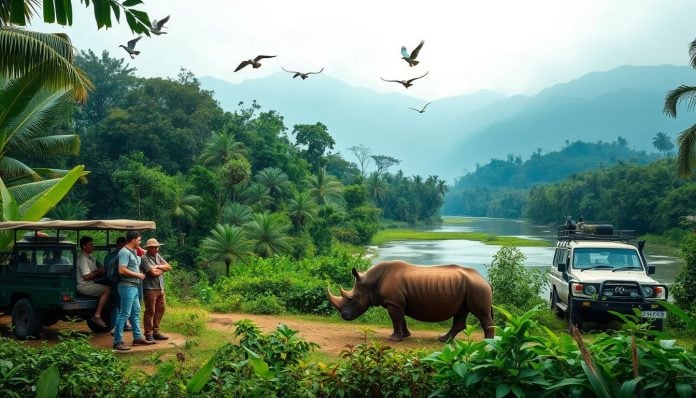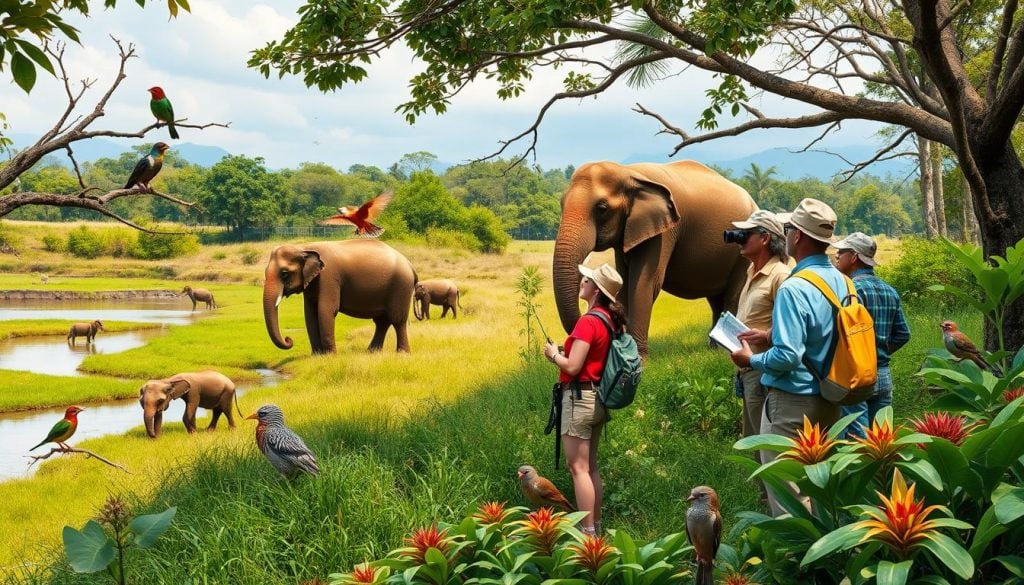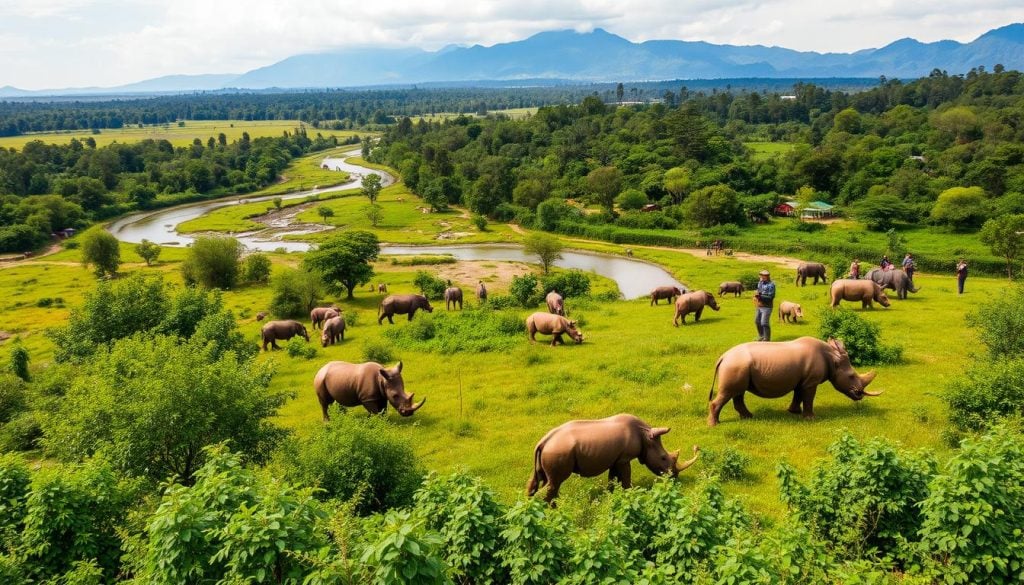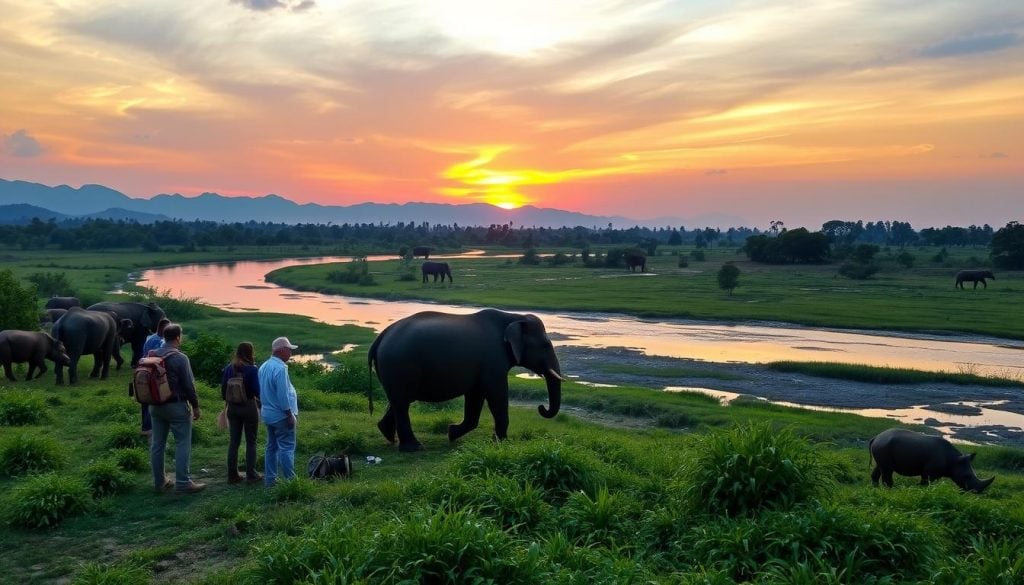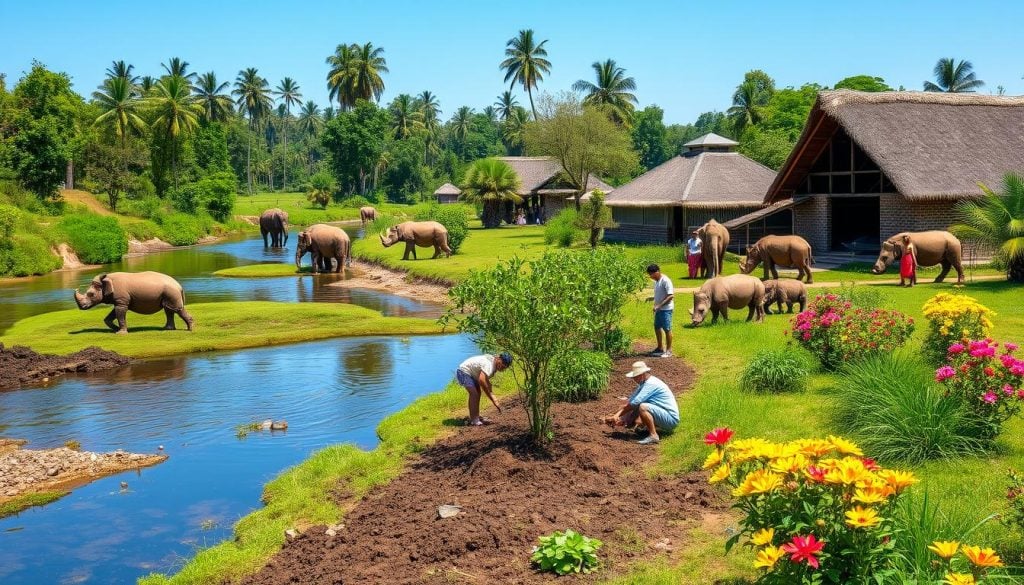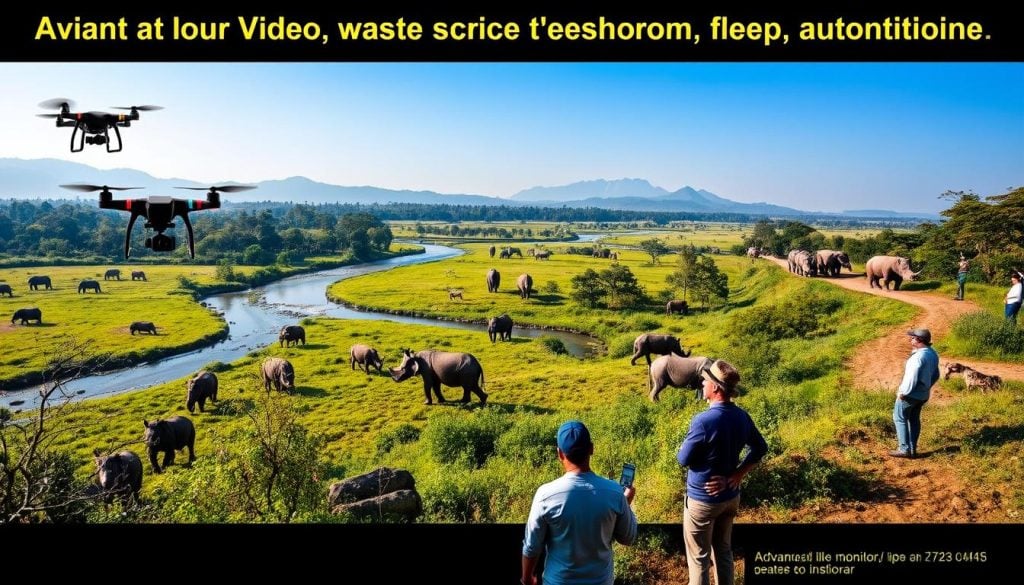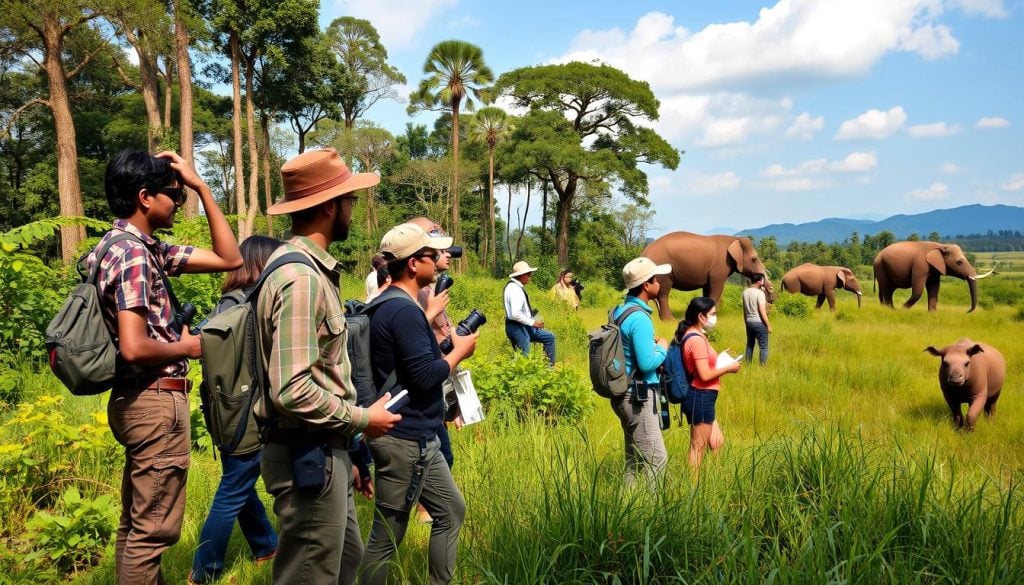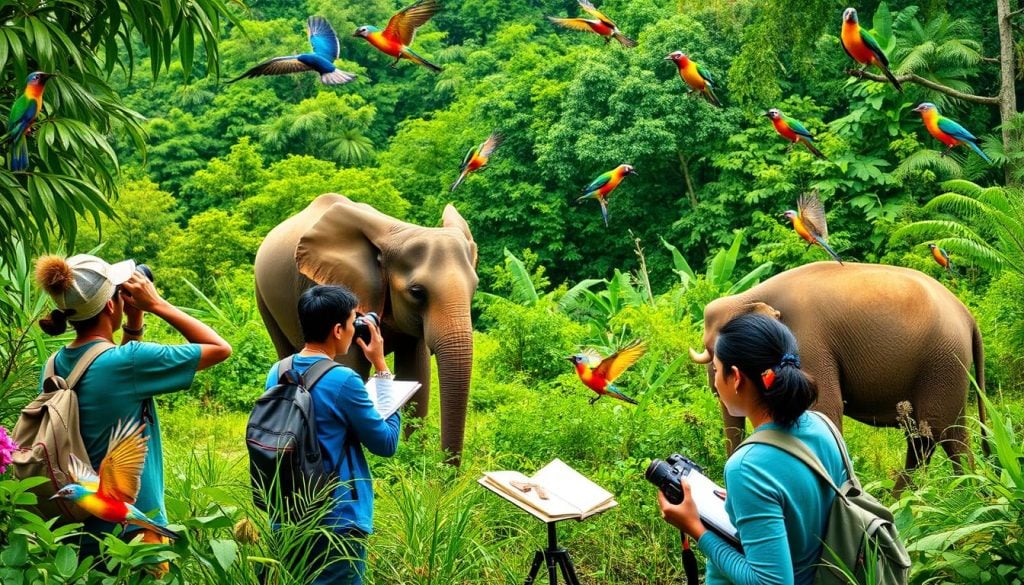Have you ever wondered how wildlife research projects in Chitwan are shaping the future of conservation? Chitwan, Nepal, is famous for its stunning landscapes and iconic animals like the greater one-horned rhino and Bengal tiger. It’s also a center for new wildlife conservation efforts.
These projects help track animal numbers, solve conflicts between humans and wildlife, and support sustainable living. This benefits both the animals and the people living nearby.
The Value of Wildlife Research in Chitwan
Wildlife research in Chitwan helps us understand the local ecosystems and the animals living there. It studies how animals behave, their numbers, and where they live. This knowledge is key for protecting biodiversity and ecosystems.
Studies in Chitwan look at many plants and animals, showing the area’s rich nature. Researchers collect data on how species interact with their surroundings. This is important for making good conservation plans.
It’s important to involve local people in wildlife conservation. When they help with research, they become part of protecting their environment. This teamwork builds a sense of responsibility and helps avoid problems with wildlife in farms.
| Research Focus | Importance | Impact on Conservation |
|---|---|---|
| Species Distribution | Understanding population changes and migration patterns | Informs protective measures for vulnerable species |
| Habitat Assessment | Evaluating ecosystem health and biodiversity | Aids in habitat restoration efforts |
| Human-Wildlife Conflict | Examining interactions between wildlife and local communities | Develops strategies to minimize conflicts and enhance coexistence |
Understanding Biodiversity Studies in Chitwan
Biodiversity studies in Chitwan are key to understanding the complex life in this unique area. They explore how species, habitats, and humans interact. These studies show why we need to protect wildlife and keep ecosystems balanced, despite challenges like habitat loss and climate change.
Research looks at birds and butterflies, important signs of the environment’s health. By watching these creatures, scientists collect data that helps protect biodiversity. This knowledge helps local communities understand and value their role in nature.
Beyond just collecting data, these studies push for sustainable living and raise awareness about human impact on wildlife. They encourage local people to join in conservation efforts through education and community involvement.
- Understanding species interactions
- Monitoring ecologically significant species
- Promoting conservation education
As research continues, it paints a detailed picture of Chitwan’s ecosystem. This ensures that wildlife conservation efforts have a strong base for long-term success.
| Key Components | Importance |
|---|---|
| Species Monitoring | Identifies population trends and health indicators |
| Ecological Research | Informs conservation strategies and policy-making |
| Community Engagement | Fosters local stewardship and awareness |
Wildlife Research Projects in Chitwan
Wildlife research in Chitwan is key to understanding and saving the area’s biodiversity. These projects watch over different species and their homes. They use new methods and work with local people. This makes conservation plans better and more effective.
Overview of Ongoing Research Initiatives
Many wildlife research projects in Chitwan use programs to track important species. Camera traps and data collection help learn about rhinos and tigers. This knowledge is vital for the health of the ecosystem.
Key Species Monitored
The greater one-horned rhino and Bengal tiger are watched closely because they are endangered. Thanks to conservation, rhino numbers are rising. Tigers, with about 128 in Chitwan National Park, are also monitored to protect them. Bird surveys add more insights into the ecosystem’s health.
Endangered Species Monitoring Efforts
Monitoring endangered species is key to saving the greater one-horned rhino. There are only 694 rhinos in Chitwan. Teams track their movements and behaviors using field observations and camera traps.
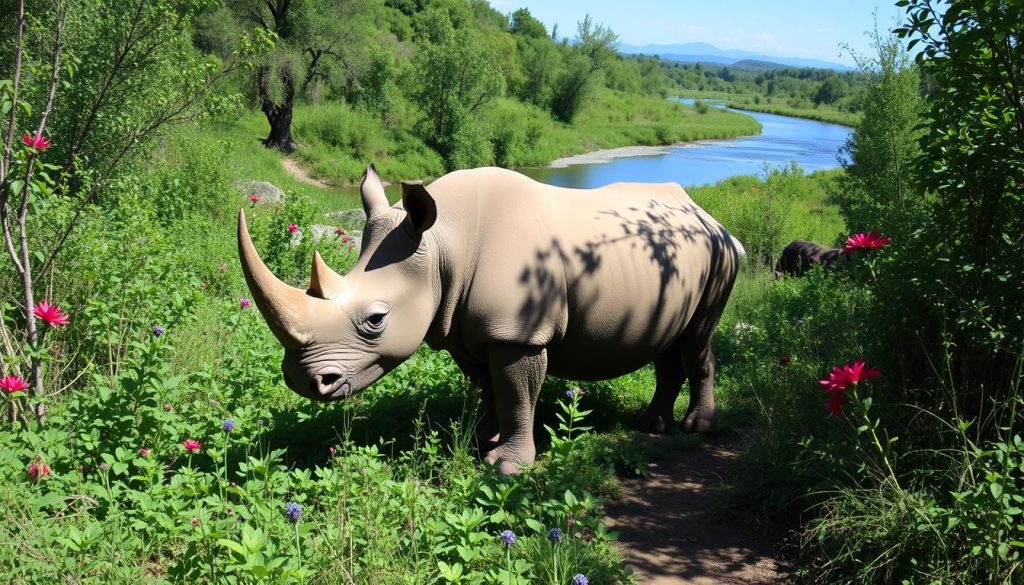
The Greater One-Horned Rhino
The greater one-horned rhino needs special care. Community Forests provide safe spaces for them. This helps reduce conflicts with humans and supports their conservation.
Conservation Status and Challenges
Despite progress, challenges like poaching and habitat loss remain. Poaching is mainly for the illegal horn trade. To fight this, conservationists use education and strict laws.
They also raise awareness about protecting these animals. This involves working with local communities and teaching them about the importance of wildlife and humans living together.
Engaging with Local Conservation Initiatives
Getting involved in local conservation efforts is key to protecting wildlife. These projects show how important it is for communities to help protect animals. They focus on things like stopping poaching and fixing habitats.
These efforts not only help animals but also solve problems between humans and wildlife. They find ways to help farmers who face issues with wildlife. This way, both nature and farming can thrive together.
When people in the community join in, they feel more connected to protecting nature. Their dedication to saving wildlife grows. This creates a lasting plan for future conservation work.
| Local Conservation Initiatives | Description | Impact on Wildlife Conservation Efforts |
|---|---|---|
| Community Patrol Programs | Involvement of local residents in monitoring wildlife and reporting illegal activities. | Reduction in poaching incidents and increased wildlife safety. |
| Habitat Restoration Projects | Restoration of natural habitats to support diverse wildlife. | Improved ecosystem health and increased biodiversity. |
| Education and Awareness Campaigns | Programs aimed at educating the community about local flora and fauna. | Enhanced community engagement and support for conservation measures. |
| Support for Sustainable Agriculture | Training farmers on practices that reduce wildlife conflicts. | Minimized human-wildlife conflict, promoting coexistence. |
Habitat Preservation Efforts in Chitwan
In Chitwan, saving habitats is a big deal. It shows how important it is to work together with the community. Local people play a big role in taking care of nature, especially in community forests.
This effort helps restore the environment and supports local people. It’s a win-win for both nature and the community.
Impact of Community Forests
Community forests are key in saving habitats. They help manage resources in a way that’s good for the environment. This makes ecosystems better and helps more species live there.
These forests also give local people important resources. They help the environment and support the community. The main benefits are:
- Restoring damaged ecosystems.
- Helping endangered animals like the greater one-horned rhino.
- Creating jobs through green practices.
Buffer Zones and Their Significance
Buffer zones around Chitwan National Park are very important. They help keep humans and wildlife safe. They also let people keep using resources.
Good management in these zones helps everyone. It lets people farm while protecting animals. The main points are:
- Keeping wildlife safe and reducing trouble.
- Helping humans and animals live together better.
- Getting the community involved in saving nature.
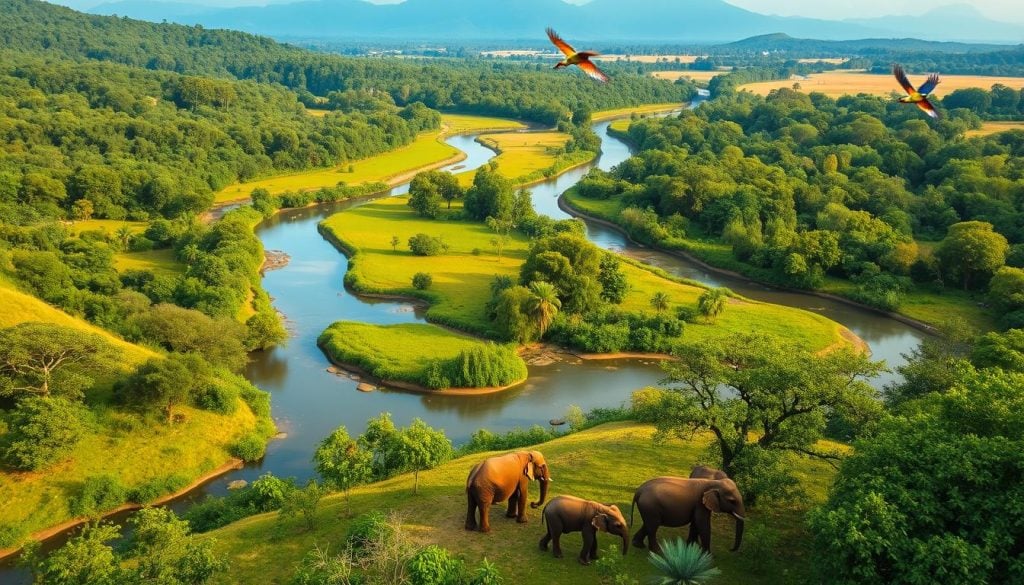
Wildlife Monitoring Programs and Technologies
Wildlife monitoring programs are key in conservation. They give us vital data on animal populations and their health. To get this info, we use many technologies.
GPS tracking, camera traps, and drone surveillance are some of these tools. They help us understand animal behaviors and trends better.
For example, GPS tracking shows where animals move. Camera traps take pictures of hard-to-find animals without disturbing them.
These tools help us quickly respond to changes in animal populations. They also help us deal with threats like habitat loss and human activities. By using these technologies, we can make research more effective and guide policy for sustainable practices.
Collaboration with Wildlife Research Organizations
Effective conservation in Chitwan depends on working with wildlife research groups. These partnerships boost the impact of local efforts. By teaming up with international NGOs and schools, local groups gain access to many resources and skills.
Community involvement in these partnerships helps people get involved in wildlife protection. This builds a strong conservation culture.
Partnerships and Community Involvement
In Chitwan, partnerships lead to new ways to tackle wildlife issues. These alliances get people involved, making them care for their natural world. Key parts of these partnerships include:
- Sharing scientific knowledge and research methods.
- Training locals in sustainable practices and wildlife watching.
- Starting educational programs to raise awareness about nature.
Global and Local Implications
Chitwan’s conservation efforts have a big impact worldwide. Successful projects help local wildlife and also fight climate change. As Chitwan’s efforts grow, they show a way for other places with similar problems.
Local actions help spread the word about protecting wildlife. They show why we need to care for nature.
Contributions of Volunteers to Chitwan Projects
Joining wildlife volunteer opportunities in Chitwan lets you help a lot with wildlife research. You get to do hands-on work that boosts conservation efforts. This support is crucial for local projects.
Hands-On Roles for Volunteers
Your role can be quite varied, including:
- Conducting bird and butterfly surveys.
- Tracking the movements of rhinos.
- Participating in habitat restoration activities.
- Assisting in community education programs.
- Implementing anti-poaching strategies.
These tasks let you dive into the local ecosystem and make a real difference. Your help is key for ongoing research and conservation. It ensures data is collected and community awareness grows.
Benefits of Participation
Being part of wildlife research projects has many perks for you, such as:
- Gaining practical experience in conservation efforts.
- Building connections with local communities.
- Developing skills in field research and data collection.
- Increasing awareness of environmental issues.
- Inspiring advocacy for wildlife conservation upon returning home.
Your volunteer work supports conservation efforts now and in the future. It shows your commitment to protecting the environment. Your efforts are crucial for wildlife protection and preservation.
Conclusion
The wildlife research projects in Chitwan show a great way to save biodiversity. They involve local communities in the effort. This is key because it helps protect endangered species and their habitats.
These projects also keep an eye on the wildlife. This is crucial for keeping the ecosystems healthy. By working together, researchers and locals make conservation more effective.
Thinking about these projects in Chitwan shows how important teamwork is. Researchers, locals, and wildlife groups work together. This teamwork tackles current problems and sets up the area for the future.
Together, they make sure Chitwan’s wildlife stays healthy. This is a gift for the next generations. It’s a chance to see the area’s wildlife thrive for years to come.
Your support for these projects can make a big difference. Helping with wildlife conservation in Chitwan is more than just a good deed. It’s a way to help the planet.
By spreading the word and getting involved, we can all help. We can all be part of saving our natural world. This is a mission we should all support.

































